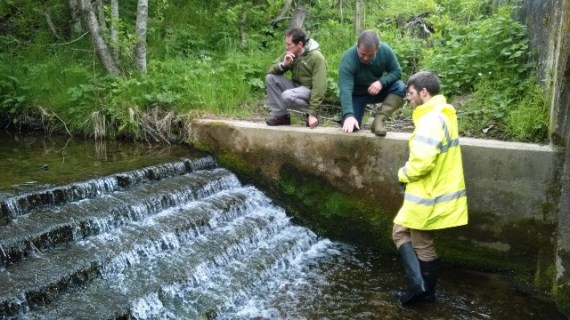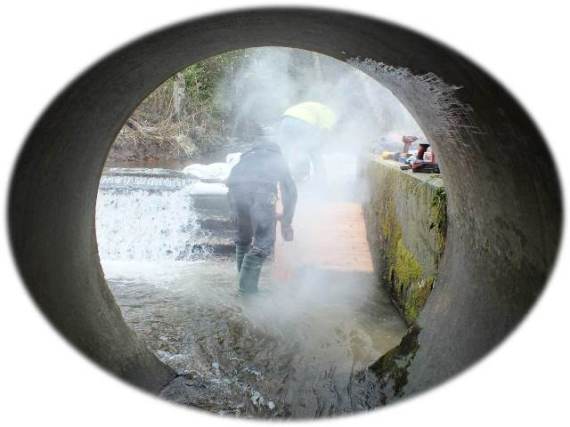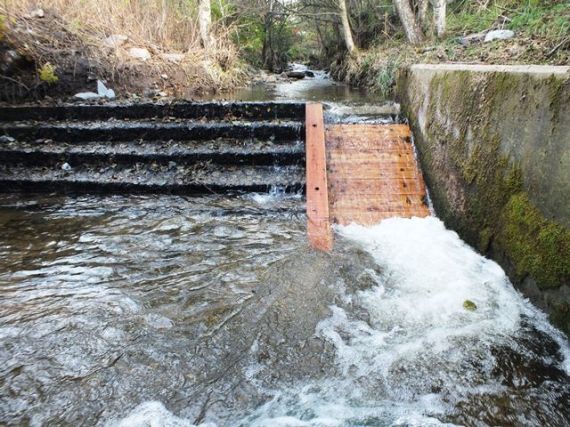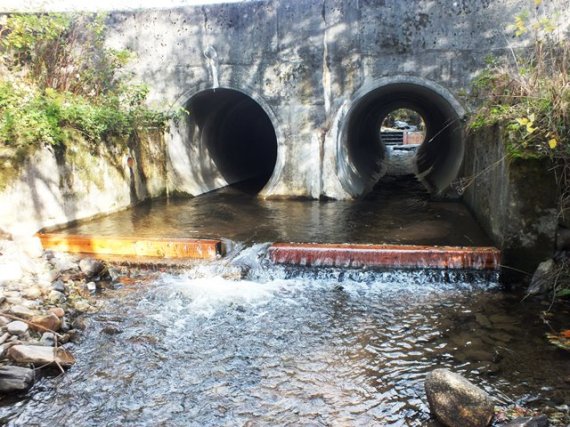The Mackalea Burn is a small tributary of the Fiddich which suffers from an unusual fish passage problem. The burn flows under the Dufftown to Huntly road via twin 2m diameter culverts. There is a concrete bridge apron on the downstream side but the major problem was the set of concrete steps on the upstream side of the road. These steps were apparently created by the road engineers in an attempt to control sediment movement. However it would be hard to envisage a more fiendishly difficult obstacle for fish passage. The steps aren’t totally impassable, in high water conditions they are effectively drowned out and some fish would get over if the water arrived at the appropriate time. Timing in this case is everything as spawning fish would only enter a wee burn such as the Mackalea on the point of spawning.
In May this year myself, Duncan Ferguson and Brian Davidson from RAFTS met at the site with Alasdair Donnelly of Moray council to discuss the improvements.

Alasdair Donnelly, Duncan Ferguson and Brian Davidson of RAFTS discuss the Mackalea steps.
Happily I can report that Moray Council subsequently agreed to our suggestion to remove a notch from the upper step with the creation of a ramp constructed from timber. We were also granted permission to fit timber baulks to the concrete apron on the downstream side to create depth over what was a very flat surface and shallow water.
Last year we entered into a sponsorship partnership with Speyburn Distillery in support if our conservation work in the Spey catchment. The Mackalea Burn was an ideal project to take forward under this partnership and in September we were able to engage local contractors to carry out the planned works.

Mark Strathdee Ltd at work installing the timber modifications to the Mackalea Burn

The timber ramp installed on the Mackalea Burn steps

Timber baulks to create depth on the formerly shallow concrete bridge apron on the downstream side of the culverts
Since the works were completed the flows in the burn have been low, this part of Scotland having missed the recent heavy rain on the west, however it is pleasing to report that a few sea trout redds have appeared in the burn upstream of the culvert.

One of two sea trout redds in close proximity a short distance upstream of the new fish pass.
Salmon have also been seen trying to ascend the steps in the past, indeed we have stocked upstream of the culverts in recent years with salmon parr. I will keep an eye on this burn in the next few weeks to see if there is any evidence of salmon above the road. A nearby B&B proprietor is also a keen fisher and he also keeps a close eye on the burn. An additional temporary baffle has been placed across the left hand culvert to create more depth at the foot of the fish pass. Subject to further observation this baffle will be a permanent fixture.
This was a nice wee project; it won’t suddenly transform the fortunes of the Spey but all the burns in ths part of the catchment are highly productive for juvenile fish given access. I would expect that in due course the population structure of the trout in this burn will become more consistently good and it will be interesting to see how the salmon respond.
We are extremely grateful to Speyburn for the sponsorship they provide and we look forward to developing other improvement projects in the future.
Spey Fishery Board
